
CAMBRIDGE, MASSACHUSETTS—According to a Science Magazine report, a team of researchers led by microbiologist Aleksandar Kostic of Harvard University analyzed eight coprolites recovered from three rock shelters in Mexico and the southwestern United States to look for traces of the ancient human microbiome. The feces ranged in age from 2,000 to 1,000 years old. First, tiny samples were rehydrated and strands of DNA were recovered by archaeologist Meradeth Snow of the University of Montana, Missoula. Marsha Wibowo of Harvard University then separated out the human intestinal DNA from that of bacteria in the surrounding soil by looking for DNA damaged by time and DNA sequences associated with mammalian guts in previous research. She also found unfamiliar DNA thought to have come from extinct bacteria. “In just these eight samples from a relatively confined geography and time period, we found 38 percent novel species,” Kostic explained. Much of the DNA came from bacteria that are also found in modern people who live in nonindustrial societies and eat a high-fiber diet. The ancient microbiomes, however, lacked markers for antibiotic resistance. Read the original scholarly article about this research in Nature.










